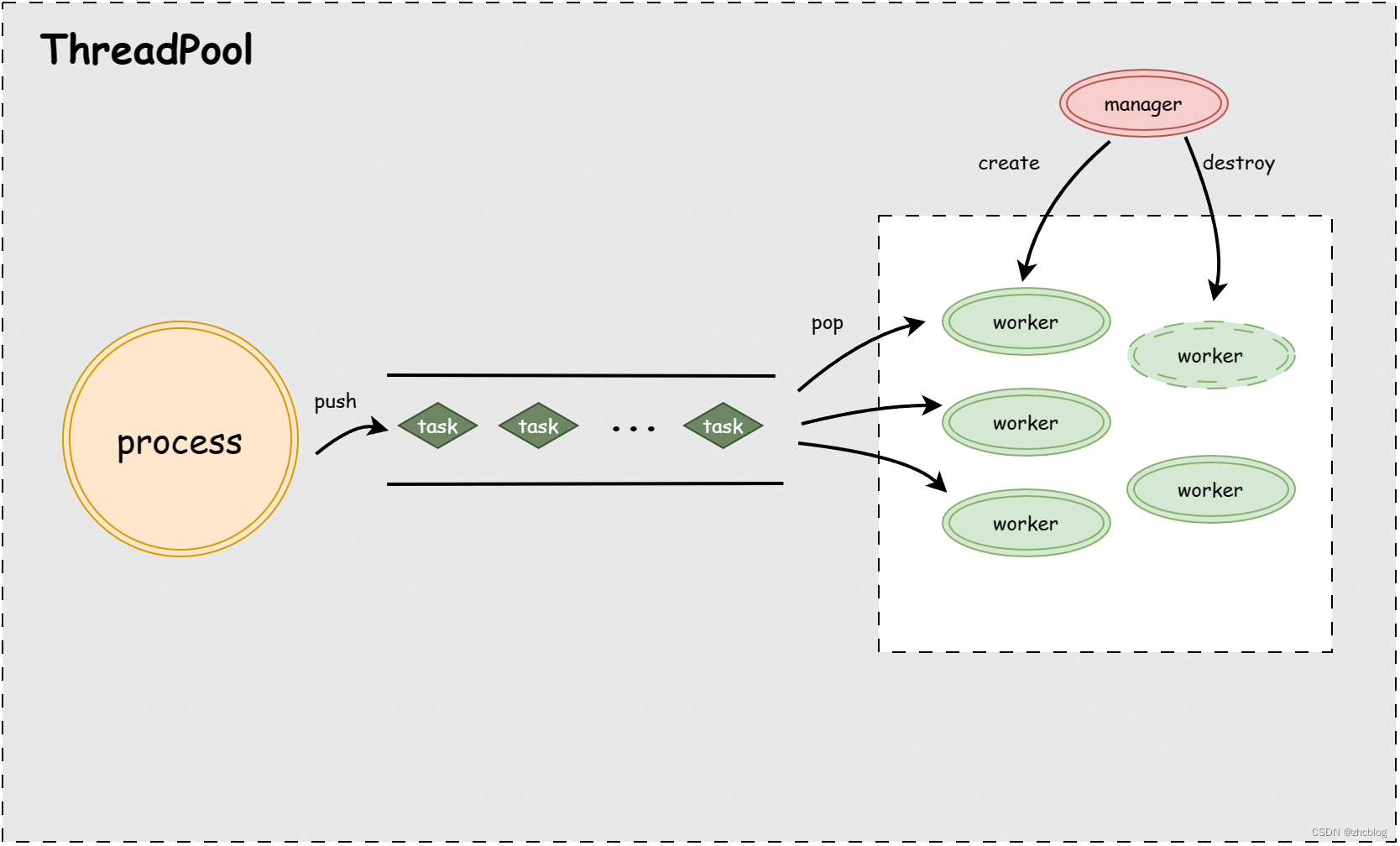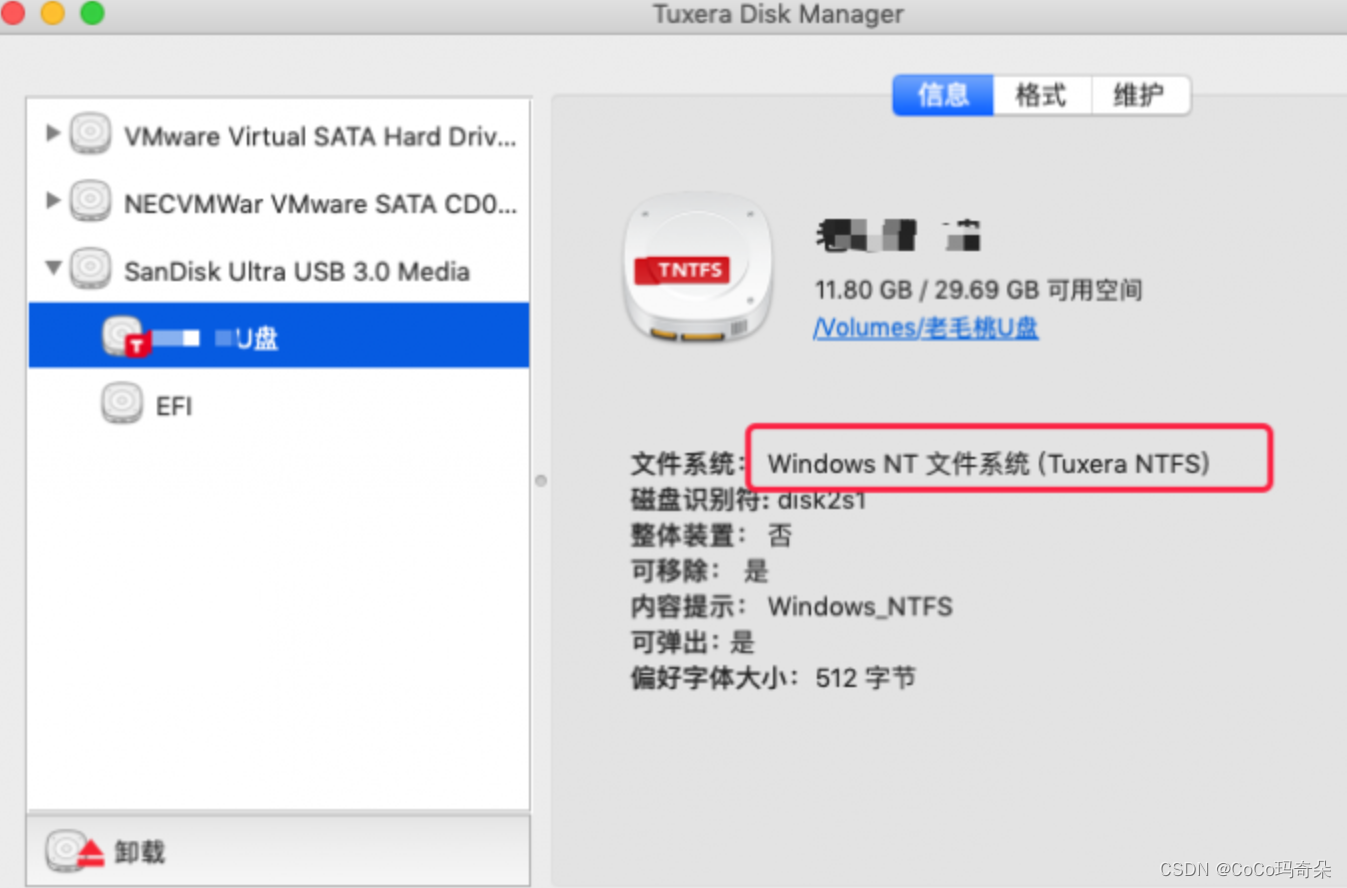一、线程池介绍
1)应用场景
当并发数很多的时候,并且每个线程执行时间很短的任务,这样就会频繁创建线程,而这样的频繁创建和销毁线程会大大降低系统的执行效率。对于这种场景我们可以使用线程池来复用之前创建的线程,降低线程的频繁创建和销毁工作,达到提高执行效率的目的。
2)线程池原理
线程池使用者往线程池任务队列里面添加任务,线程池会根据任务的多少来自动创建或销毁工作线程取执行任务,即当任务数量比较多而线程池比较少处于忙不过来的状态时,线程池就会自动创建线程,而当仍务数量比较少而空闲线程比较多时,线程池就会自动销毁一部分空闲线程。其中任务队列、线程池使用者和工作线程组成一个生产者消费者模型,线程池使用者(消费者)检查队列已满就阻塞,否则就向任务队列添加任务并通知工作线程(消费者)取任务执行,而工作线程(消费者)取任务之后也会向线程池使用者(生产者)发送通知解阻塞。
3)线程池结构
线程池由任务队列、工作线程和管理线程三部分组成,他们的所用分别如下。
- 任务队列:
- 负责保存要执行的任务(一般每个任务就是一个回调函数);
- 线程池使用者(生产者)往任务队列里面添加任务,并通知工作线程(消费者)取任务执行;
- 工作线程(消费者)从任务队列里面获取到任务后,需要把该任务从队列中删除;
- 工作线程:
- 负责执行任务队列里面的任务;
- 当任务队列没有任务时,工作线程便自动睡眠防止占用CPU资源;
- 当由任务时唤醒工作线程,从队列中取任务执行(从队列中取出任务后,如果生产者此时阻塞的话可以通知生产者解阻塞);
- 管理线程:
- 负责控制工作线程的数量;
- 当空闲的工作线程数量比较多时,就销毁一部分线程;
- 当队列任务比较多而工作线程比较少时,新创建一部分线程;

二、程序实现
1)C语言实现
threadPool.h
#ifndef _THREAD_POOL_
#define _THREAD_POOL_typedef struct ThreadPool ThreadPool;// 创建并初始化线程池
ThreadPool* threadPoolCreate(int queueSize, int minNum, int maxNum);// 销毁线程池
void threadPoolDestory(ThreadPool* pool);// 往线程池添加任务
int threadPoolAdd(ThreadPool* pool, void (*handler)(void* arg), void* arg);// 获取线程池当前工作线程数
int threadPoolWorkNum(ThreadPool* pool);// 获取线程池当前存活线程数
int threadPoolLiveNum(ThreadPool* pool);#endif // _THREAD_POOL_
threadPool.c
#include "threadPool.h"
#include <stdio.h>
#include <pthread.h>
#include <stdlib.h>
#include <error.h>
#include <string.h>
#include <unistd.h>#define CHAGNUM 4void* worker(void *arg);
void* manager(void *arg);
void threadExit(ThreadPool* pool);typedef struct Task {void (*handler)(void* arg);void* arg;
}Task;struct ThreadPool {Task* taskQ;int qCapacity;int qSize;int qFront;int qBack;pthread_t manageID;pthread_t* workIDs;int maxNum; // 最大线程数量int minNum; // 最小线程数量int workNum; // 正在执行任务的工作线程数量int liveNum; // 当前已创建的的工作线程数量int exitNum; // 需要销毁退出的线程数量pthread_mutex_t mutexPool;pthread_mutex_t mutexWork; // 锁workNum变量pthread_cond_t hasTask; // 任务队列是否有任务pthread_cond_t isFull; // 任务队列是否已满int isDestory; // 线程池是否销毁
};ThreadPool* threadPoolCreate(int queueSize, int minNum, int maxNum)
{int i, res = 0;// 创建线程池对象ThreadPool* tPool = (ThreadPool*)malloc(sizeof(struct ThreadPool));if (tPool == NULL) {perror("tPool malloc:");goto err;}// 创建任务队列tPool->taskQ = (Task*)malloc(sizeof(struct Task) * queueSize);if (tPool->taskQ == NULL) {perror("taskQ malloc:");goto err;}tPool->qSize = 0;tPool->qCapacity = queueSize;tPool->qFront = tPool->qBack = 0;// 创建存储工作线程ID的数组tPool->workIDs = (pthread_t*)malloc(sizeof(pthread_t) * maxNum);if (tPool->workIDs == NULL) {perror("workIDs malloc:");goto err;}memset(tPool->workIDs, 0, sizeof(pthread_t) * maxNum);tPool->maxNum = maxNum;tPool->minNum = minNum;tPool->workNum = 0;tPool->liveNum = minNum;tPool->exitNum = 0;tPool->isDestory = 0;// 初始化互斥量和条件变量if (pthread_mutex_init(&tPool->mutexPool, NULL) != 0 ||pthread_mutex_init(&tPool->mutexWork, NULL) != 0 ||pthread_cond_init(&tPool->isFull, NULL) != 0 ||pthread_cond_init(&tPool->hasTask, NULL) != 0) {printf("mutex or cond init fail...\n");goto err;}// 创建工作线程for (i = 0; i < minNum; i++) {res = pthread_create(&tPool->workIDs[i], NULL, worker, tPool);if (res != 0) { printf("thread create failed for worker, errno: %d, idx: %d\n", res, i);goto err;}}// 创建管理线程res = pthread_create(&tPool->manageID, NULL, manager, tPool);if (res != 0) {printf("thread create failed for manager, errno: %d\n", res);goto err;}return tPool;err:if (tPool && tPool->taskQ) {free(tPool->taskQ);tPool->taskQ = NULL;}if (tPool && tPool->workIDs) {free(tPool->workIDs);tPool->workIDs = NULL;}if (tPool) {free(tPool);}return NULL;
}void* worker(void *arg)
{Task task;ThreadPool* pool = (ThreadPool*)arg;while(1) {pthread_mutex_lock(&pool->mutexPool);// 队列为空就阻塞当前线程,避免占用CPUwhile(pool->qSize == 0 && !pool->isDestory) {pthread_cond_wait(&pool->hasTask, &pool->mutexPool);// 减少空闲线程if (pool->exitNum > 0) {pool->exitNum--;if (pool->liveNum > pool->minNum) {pool->liveNum--;pthread_mutex_unlock(&pool->mutexPool);threadExit(pool);}}}// 销毁线程池if (pool->isDestory) {pool->liveNum--;pthread_mutex_unlock(&pool->mutexPool);threadExit(pool);}// 取一个任务执行task.arg = pool->taskQ[pool->qFront].arg;task.handler = pool->taskQ[pool->qFront].handler;pool->qFront = (pool->qFront + 1) % pool->qCapacity;pool->qSize--;pthread_cond_signal(&pool->isFull);pthread_mutex_unlock(&pool->mutexPool);pthread_mutex_lock(&pool->mutexWork);pool->workNum++;pthread_mutex_unlock(&pool->mutexWork);task.handler(task.arg);if (task.arg) { // 释放资源 或者 用户在回调函数中释放这里就不释放了free(task.arg);task.arg = NULL;}pthread_mutex_lock(&pool->mutexWork);pool->workNum--;pthread_mutex_unlock(&pool->mutexWork);}return NULL;
}void* manager(void *arg)
{int i = 0, incNum = CHAGNUM;ThreadPool* pool = (ThreadPool*)arg;while(!pool->isDestory) {sleep(3);pthread_mutex_lock(&pool->mutexPool);int queueSize = pool->qSize;int liveNum = pool->liveNum;pthread_mutex_unlock(&pool->mutexPool);pthread_mutex_lock(&pool->mutexWork);int workNum = pool->workNum;pthread_mutex_unlock(&pool->mutexWork);// 数据处理不过来要增加线程if (queueSize > liveNum) {pthread_mutex_lock(&pool->mutexPool);for(i = 0; i < pool->maxNum && incNum > 0; i++) {if (pool->workIDs[i] == 0) {pthread_create(&pool->workIDs[i], NULL, worker, pool);incNum--;pool->liveNum++;printf("new thread %ld, liveNum = %d, workNum = %d\n",pool->workIDs[i], pool->liveNum, pool->workNum);}}pthread_mutex_unlock(&pool->mutexPool);}// 空闲线程多了要销毁if(workNum * 2 < liveNum &&liveNum - CHAGNUM > pool->minNum) {pthread_mutex_lock(&pool->mutexPool);pool->exitNum = CHAGNUM;pthread_mutex_unlock(&pool->mutexPool);for (i = 0; i < CHAGNUM; i++) {pthread_cond_signal(&pool->hasTask);}}}return NULL;
}int threadPoolAdd(ThreadPool* pool, void (*handler)(void* arg), void* arg)
{pthread_mutex_lock(&pool->mutexPool);while(pool->qSize == pool->qCapacity && !pool->isDestory) {pthread_cond_wait(&pool->isFull, &pool->mutexPool);}if (pool->isDestory) {pthread_mutex_unlock(&pool->mutexPool);return -1;}pool->taskQ[pool->qBack].arg = arg;pool->taskQ[pool->qBack].handler = handler;pool->qBack = (pool->qBack + 1) % pool->qCapacity;pool->qSize++;pthread_cond_signal(&pool->hasTask); // 通知空闲的工作线程取任务执行pthread_mutex_unlock(&pool->mutexPool);return 0;
}void threadExit(ThreadPool* pool)
{int i;pthread_t tid = pthread_self();for(i = 0; i < pool->maxNum; i++) {if (pool->workIDs[i] == tid) {pool->workIDs[i] = 0;break;}}printf("thread %ld exit, liveNum = %d, workNum = %d\n",tid, pool->liveNum, pool->workNum);pthread_exit(0);
}int threadPoolWorkNum(ThreadPool* pool)
{int workNum;pthread_mutex_lock(&pool->mutexWork);workNum = pool->workNum;pthread_mutex_unlock(&pool->mutexWork);return workNum;
}int threadPoolLiveNum(ThreadPool* pool)
{int liveNum;pthread_mutex_lock(&pool->mutexPool);liveNum = pool->liveNum;pthread_mutex_unlock(&pool->mutexPool);return liveNum;
}void threadPoolDestory(ThreadPool* pool)
{int i;if (pool == NULL) {return;}pool->isDestory = 1;// 销毁管理线程pthread_join(pool->manageID, NULL);// 销毁工作线程for (i = 0; i < pool->maxNum; i++) {if (pool->workIDs[i] > 0) {pthread_cond_signal(&pool->hasTask);}}for (i = 0; i < pool->maxNum; i++) {if (pool->workIDs[i] > 0) {pthread_join(pool->workIDs[i], NULL);}}pthread_mutex_destroy(&pool->mutexPool);pthread_mutex_destroy(&pool->mutexWork);pthread_cond_destroy(&pool->hasTask);if (pool->workIDs) {free(pool->workIDs);pool->workIDs = NULL;}if (pool->taskQ) {free(pool->taskQ);pool->taskQ = NULL;}free(pool);printf("thread pool destory...\n");
}main.c
#include "threadPool.h"
#include <stdio.h>
#include <pthread.h>
#include <stdlib.h>
#include <unistd.h>void myTest(void *arg)
{printf("tid: %ld, num = %d\n", pthread_self(), *(int *)arg);sleep(3);
}int main()
{int i;ThreadPool *pool = threadPoolCreate(20, 4, 10);for (i = 0; i < 40; i++) {int* num = (int *)malloc(sizeof(int));*num = i;threadPoolAdd(pool, myTest, num);}sleep(10);threadPoolDestory(pool);return 0;
}
2)C++实现
threadPool.h
#ifndef _THREADPOOL_H
#define _THREADPOOL_H
#include <pthread.h>
#include <string.h>
#include <unistd.h>
#include <queue>struct Task {void (*handler)(void*);void* arg = nullptr;
};class TaskQueue {
public:TaskQueue();~TaskQueue();// 添加任务void addTask(Task& task);void addTask(void (*handler)(void*), void* arg);// 取出任务Task getTask();// 获取任务数inline int getTaskNum();private:pthread_mutex_t m_lock;std::queue<Task> m_que;
};class ThreadPool {
public:ThreadPool(int max, int min);~ThreadPool();// 添加任务void addTask(Task task);// 获取工作线程数int getWorkNum();// 获取存活线程数int getLiveNum();private:static void* worker(void* arg);static void* manager(void* arg);void threadExit();private:TaskQueue m_taskQ;int m_maxNum;int m_minNum;int m_workNum;int m_liveNum;int m_exitNum;static const int m_changeNum = 2;bool m_isDestory = false;pthread_t m_managerTid;pthread_t* m_workTids;pthread_cond_t m_hasTask;pthread_mutex_t m_lock; // 锁m_workNUm、m_liveNum、m_exitNum变量
};#endif // _THREADPOOL_H
threadPool.cpp
#include "threadPool.h"
#include <iostream>ThreadPool::ThreadPool(int max, int min)
{int i;m_maxNum = max;m_minNum = min;m_workNum = 0;m_liveNum = min;m_exitNum = 0;if (pthread_cond_init(&m_hasTask, nullptr) != 0|| pthread_mutex_init(&m_lock, nullptr) != 0) {std::cout << "cond or mutex init fail..." << std::endl;return;}m_workTids = new pthread_t[m_maxNum];if(m_workTids == nullptr) {std::cout << "m_workTids malloc failed..." << std::endl;}memset(m_workTids, 0, sizeof(pthread_t) * m_maxNum);// 创建工作线程for (i = 0; i < m_minNum; i++) {pthread_create(&m_workTids[i], nullptr, worker, this); std::cout << "worker thread " << m_workTids[i] << " created" << std::endl;}// 创建管理线程pthread_create(&m_managerTid, nullptr, manager, this);
}ThreadPool::~ThreadPool()
{m_isDestory = true;pthread_join(m_managerTid, nullptr);pthread_cond_broadcast(&m_hasTask);for (int i = 0; i < m_maxNum; i++) {if (m_workTids[i] != 0) {pthread_join(m_workTids[i], nullptr);std::cout << "thread i = " << i << " tid = " << m_workTids[i] << " exit..." << std::endl;m_workTids[i] = 0;}}pthread_mutex_destroy(&m_lock);pthread_cond_destroy(&m_hasTask);if (m_workTids) {delete []m_workTids;}std::cout << "liveNum = "<< m_liveNum <<", workNum = "<< m_workNum <<", queSize = " << this->m_taskQ.getTaskNum() << std::endl;
}void* ThreadPool::worker(void* arg)
{ThreadPool* pool = static_cast<ThreadPool*>(arg);while(1) {pthread_mutex_lock(&pool->m_lock);while(pool->m_taskQ.getTaskNum() == 0 && !pool->m_isDestory) {std::cout << "thread " << pthread_self() << " waitting..." << std::endl;pthread_cond_wait(&pool->m_hasTask, &pool->m_lock);// 空闲线程退出if (pool->m_exitNum > 0) {pool->m_exitNum--;if(pool->m_liveNum > pool->m_minNum) { pool->m_liveNum--;pthread_mutex_unlock(&pool->m_lock);pool->threadExit();}}}// 销毁线程池if (pool->m_isDestory) {pool->m_liveNum--;pthread_mutex_unlock(&pool->m_lock);pthread_exit(0); // 这里不调用threadExit是让主线程好回收资源}// 取任务执行Task task = pool->m_taskQ.getTask();pool->m_workNum++;pthread_mutex_unlock(&pool->m_lock);task.handler(task.arg); // 用户自己取释放arg内存pthread_mutex_lock(&pool->m_lock);pool->m_workNum--;pthread_mutex_unlock(&pool->m_lock);}return nullptr;
}void* ThreadPool::manager(void* arg)
{ThreadPool* pool = static_cast<ThreadPool*>(arg);while(!pool->m_isDestory) {sleep(3);int liveNum;int taskNum;int workNum;int i, incNum = pool->m_changeNum;pthread_mutex_lock(&pool->m_lock);liveNum = pool->m_liveNum;workNum = pool->m_workNum;taskNum = pool->m_taskQ.getTaskNum();pthread_mutex_unlock(&pool->m_lock);// 任务太多忙不过来需要创建线程if(!pool->m_isDestory && taskNum > liveNum && liveNum < pool->m_maxNum) {for (i = 0; i < pool->m_maxNum && incNum > 0 ; i++) {pthread_mutex_lock(&pool->m_lock);if (pool->m_workTids[i] == 0) {pool->m_liveNum++;incNum--;pthread_create(&pool->m_workTids[i], NULL, worker, pool);std::cout << "new thread " << pool->m_workTids[i] << " created" << std::endl;}pthread_mutex_unlock(&pool->m_lock);}}// 销毁多余的空闲线程incNum = pool->m_changeNum;if (!pool->m_isDestory && workNum * 2 < liveNum && liveNum > pool->m_minNum) {pthread_mutex_lock(&pool->m_lock);pool->m_exitNum = pool->m_changeNum;pthread_mutex_unlock(&pool->m_lock);while (incNum--) {pthread_cond_signal(&pool->m_hasTask);}}}return nullptr;
}void ThreadPool::addTask(Task task)
{if (m_isDestory) {return;}pthread_mutex_lock(&m_lock);m_taskQ.addTask(task);pthread_mutex_unlock(&m_lock);pthread_cond_signal(&m_hasTask);
}void ThreadPool::threadExit()
{for (int i = 0; i < m_maxNum; i++) {if (m_workTids[i] == pthread_self()) {std::cout << "thread " << m_workTids[i] << " exit..." << std::endl;pthread_mutex_lock(&m_lock);m_workTids[i] = 0;pthread_mutex_unlock(&m_lock);pthread_exit(0);}}
}int ThreadPool::getWorkNum()
{int workNum = 0;pthread_mutex_lock(&m_lock);workNum = m_workNum;pthread_mutex_unlock(&m_lock);return m_workNum;
}int ThreadPool::getLiveNum()
{int liveNum = 0;pthread_mutex_lock(&m_lock);liveNum = m_liveNum;pthread_mutex_unlock(&m_lock);return liveNum;
}TaskQueue::TaskQueue()
{pthread_mutex_init(&m_lock, NULL);
}TaskQueue::~TaskQueue()
{pthread_mutex_destroy(&m_lock);
}void TaskQueue::addTask(Task& task)
{pthread_mutex_lock(&this->m_lock);m_que.push(task);pthread_mutex_unlock(&this->m_lock);
}void TaskQueue::addTask(void (*handler)(void*), void* arg)
{Task task;task.arg = arg;task.handler = handler; pthread_mutex_lock(&this->m_lock);m_que.push(task);pthread_mutex_unlock(&this->m_lock);
}Task TaskQueue::getTask()
{Task task;pthread_mutex_lock(&this->m_lock);if (m_que.size() > 0) {task = m_que.front();m_que.pop();}pthread_mutex_unlock(&this->m_lock);return task;
}inline int TaskQueue::getTaskNum()
{return this->m_que.size();
}
main.cpp
#include "threadPool.h"
#include <iostream>
using namespace std;void my_test(void* arg)
{int num = *(int*)arg;cout << "thread id: " << pthread_self() << " , num: " << num << endl;sleep(1);delete (int*)arg;
}int main()
{ThreadPool* pool = new ThreadPool(10, 4);sleep(1);for (int i = 0; i < 30; i++) {Task task;task.handler = my_test;task.arg = new int(i);pool->addTask(task);}sleep(10);delete pool;return 0;
}







